Assessment of Spatio-Temporal Variation and Driving Mechanism of Ecological Environment Quality in the Arid Regions of Central Asia, Xinjiang
Abstract
:1. Introduction
2. Materials and Methods
2.1. Study Site
2.2. Data Sources
2.3. Methods
2.3.1. Calculation of Indicators
- Gross primary productivity (GPP) and leaf area index (LAI)
- 2
- Fractional vegetation coverage (FVC)
- 3
- Land surface temperature (LST) and modified wetness (WET)
2.3.2. The Calculation of the Ecological Quality Index
2.3.3. Interpolation of Meteorological Data
2.3.4. Calculation of the Grazing Pressure Index
2.3.5. Spatial Auto-Correlation Analysis
3. Results
3.1. Basic Statistical Value of the Ecological Quality Index
3.2. The Spatial Distribution of MODEI
3.3. Changes in MODEI from 2008 to 2018
3.4. Simulation and Prediction of the MODEI
4. Discussion
4.1. Climate Change and Its Influence on the MODEI
4.2. Impact of Human Activities on the MODEI
4.2.1. Changes in the Grazing Pressure Index
4.2.2. Changes in Land Use
4.3. Limitations and Future Perspectives
5. Conclusions
Author Contributions
Funding
Institutional Review Board Statement
Informed Consent Statement
Data Availability Statement
Conflicts of Interest
References
- Zhang, X.S. Ecological restoration and sustainable agricultural paradigm of Mountain-Oasis-Ecotone-Desert system in the north of the Tianshan Mountains. Acta Bot. Sin. 2001, 43, 1294–1299. (In Chinese) [Google Scholar]
- Wu, N.; Liu, A.; Wang, Y.; Li, L.; Chao, L.; Liu, G. An Assessment Framework for Grassland Ecosystem Health with Consideration of Natural Succession: A Case Study in Bayinxile, China. Sustainability 2019, 11, 1096. [Google Scholar] [CrossRef] [Green Version]
- Groom, G.; Mücher, C.A.; Ihse, M.; Wrbka, T. Remote Sensing in Landscape Ecology: Experiences and Perspectives in a European Context. Landsc. Ecol. 2006, 21, 391–408. [Google Scholar] [CrossRef]
- Willis, K.S. Remote sensing change detection for ecological monitoring in United States protected areas. Biol. Conserv. 2015, 182, 233–242. [Google Scholar] [CrossRef]
- Ochoa-Gaona, S.; Kampichler, C.; de Jong, B.; Hernández, S.; Geissen, V.; Huerta, E. A multi-criterion index for the evaluation of local tropical forest conditions in Mexico. For. Ecol. Manag. 2010, 260, 618–627. [Google Scholar] [CrossRef]
- Sullivan, C.A.; Skeffington, M.S.; Gormally, M.J.; Finn, J. The ecological status of grasslands on lowland farmlands in western Ireland and implications for grassland classification and nature value assessment. Biol. Conserv. 2010, 143, 1529–1539. [Google Scholar] [CrossRef]
- Gupta, K.; Kumar, P.; Pathan, S.; Sharma, K. Urban Neighborhood Green Index—A measure of green spaces in urban areas. Landsc. Urban Plan. 2012, 105, 325–335. [Google Scholar] [CrossRef]
- Chen, X.Y.; Chau, K.W. A Hybrid Double Feedforward Neural Network for Suspended Sediment Load Estimation. Water Resour. Manag. 2016, 30, 2179–2194. [Google Scholar] [CrossRef]
- Shamshirband, S.; Nodoushan, E.J.; Adolf, J.E.; Manaf, A.A.; Mosavi, A.; Chau, K.-W. Ensemble models with uncertainty analysis for multi-day ahead forecasting of chlorophyll a concentration in coastal waters. Eng. Appl. Comput. Fluid Mech. 2018, 13, 91–101. [Google Scholar] [CrossRef] [Green Version]
- Liu, Q.H.; Wu, J.J.; Li, L.; Yu, L.; Li, J.; Xin, X.; Jia, L.; Zhong, B.; Niu, Z.; Xu, X.; et al. Ecological environment monitoring for sustainable development goals in the Belt and Road region. J. Remote Sens. 2018, 22, 686–708. [Google Scholar]
- Wang, Y.; Yue, H.; Peng, Q.; He, C.; Hong, S.; Bryan, B.A. Recent responses of grassland net primary productivity to climatic and anthropogenic factors in Kyrgyzstan. Land Degrad. Dev. 2020, 31, 2490–2506. [Google Scholar] [CrossRef]
- De Faria Peres, L.; de Lucena, A.J.; Rotunno Filho, O.C.; de Almeida França, J.R. The urban heat island in Rio de Janeiro, Brazil, in the last 30 years using remote sensing data. Int. J. Appl. Earth Obs. Geoinf. 2018, 64, 104–116. [Google Scholar] [CrossRef]
- Equere, V.; Mirzaei, P.A.; Riffat, S. Definition of a new morphological parameter to improve prediction of urban heat island. Sustain. Cities Soc. 2020, 56, 102021. [Google Scholar] [CrossRef]
- Miles, V.; Esau, I. Surface urban heat islands in 57 cities across different climates in northern Fennoscandia. Urban Clim. 2020, 31, 100575. [Google Scholar] [CrossRef]
- Ivits, E.; Cherlet, M.; Mehl, W.; Sommer, S. Estimating the ecological status and change of riparian zones in Andalusia assessed by multi-temporal AVHHR datasets. Ecol. Indic. 2009, 9, 422–431. [Google Scholar] [CrossRef]
- Xu, H. Analysis of Impervious Surface and its Impact on Urban Heat Environment using the Normalized Difference Impervious Surface Index (NDISI). Photogramm. Eng. Remote Sens. 2010, 76, 557–565. [Google Scholar] [CrossRef]
- Suter, G.W.; Norton, S.B.; Cormier, S.M. A methodology for inferring the causes of observed impairments in aquatic ecosystems. Environ. Toxicol. Chem. 2002, 21, 1101–1111. [Google Scholar] [CrossRef] [PubMed]
- Xu, H.; Wang, Y.; Guan, H.; Shi, T.; Hu, X. Detecting Ecological Changes with a Remote Sensing Based Ecological Index (RSEI) Produced Time Series and Change Vector Analysis. Remote Sens. 2019, 11, 2345. [Google Scholar] [CrossRef] [Green Version]
- Wen, X.; Ming, Y.; Gao, Y.; Hu, X. Dynamic Monitoring and Analysis of Ecological Quality of Pingtan Comprehensive Experimental Zone, a New Type of Sea Island City, Based on RSEI. Sustainability 2019, 12, 21. [Google Scholar] [CrossRef] [Green Version]
- Zhu, J.W.; Xie, X.T.; Li, X.H. A solution to the problem of ecological environmental carrying capacity evaluation: A case study of Henan Province. Acta Ecol. Sin. 2017, 37, 7039–7047. (In Chinese) [Google Scholar]
- Li, N.Y.; Tang, Y.; Yang, L.; Xiao, Z.H. Research on the current status of ecological environment quality in Baishui River Basin based on remote sensing technology. J. Huazhong Norm. Univ. 2013, 47, 103–107. (In Chinese) [Google Scholar]
- Liu, Q.F.; Xu, J.H.; Chen, L.; Zhang, S.Z. The monitoring and evaluation of ecological environment in the returned forestlands—A case study of Shaanxi province. J. Heilongjiang Inst. Technol. 2018, 32, 20–26. (In Chinese) [Google Scholar]
- Xu, H.Q. A remote sensing urban ecological index and its application. Acta Ecol. Sin. 2013, 33, 7853–7862. (In Chinese) [Google Scholar]
- Zhang, C.; Xu, H.Q.; Zhang, H.; Tang, F.; Lin, Z.L. Fractional vegetation cover change and its ecological effect assessment in a typical reddish soil region of southeastern China: Changting County, Fujian Province. J. Nat. Resour. 2015, 6, 917–928. (In Chinese) [Google Scholar]
- Yang, F.; Song, J.; Zhao, Y.; Zhao, J.; Niu, C. Dynamic Monitoring of Ecological Environment in Black Soil Erosion Area of Northeast China Based on Remote Sensing. Res. Environ. Sci. 2018, 31, 1580–1587. [Google Scholar]
- Zhang, X.D.; Liu, X.N.; Zhao, Z.P.; Ma, Y.Y.; Yang, Y. Dynamic monitoring of ecology and environment in the agro-pastral ecotone based on remote sensing: A case of Yanchi County in Ningxia Hui Autonomous Region. Arid Land Geogr. 2017, 5, 1070–1078. (In Chinese) [Google Scholar]
- Hu, X.; Xu, H. A new remote sensing index for assessing the spatial heterogeneity in urban ecological quality: A case from Fuzhou City, China. Ecol. Indic. 2018, 89, 11–21. [Google Scholar] [CrossRef]
- Xu, H.; Wang, M.; Shi, T.; Guan, H.; Fang, C.; Lin, Z. Prediction of ecological effects of potential population and impervious surface increases using a remote sensing based ecological index (RSEI). Ecol. Indic. 2018, 93, 730–740. [Google Scholar] [CrossRef]
- Shan, W.; Jin, X.; Ren, J.; Wang, Y.; Xu, Z.; Fan, Y.; Gu, Z.; Hong, C.; Lin, J.; Zhou, Y. Ecological environment quality assessment based on remote sensing data for land consolidation. J. Clean. Prod. 2019, 239, 118126. [Google Scholar] [CrossRef]
- Yuan, B.; Fu, L.; Zou, Y.; Zhang, S.; Chen, X.; Li, F.; Deng, Z.; Xie, Y. Spatiotemporal change detection of ecological quality and the associated affecting factors in Dongting Lake Basin, based on RSEI. J. Clean. Prod. 2021, 302, 126995. [Google Scholar] [CrossRef]
- Wang, L.C.; Jiao, L.; Lai, F.B.; Zhang, N.M. Evaluation of ecological changes based on a remote sensing ecological index in a Manas Lake wetland, Xinjiang. Acta Ecol. Sin. 2019, 39, 2963–2972. (In Chinese) [Google Scholar]
- Huang, J.; Yu, H.; Dai, A.; Wei, Y.; Kang, L. Drylands face potential threat under 2 °C global warming target. Nat. Clim. Chang. 2017, 7, 417–422. [Google Scholar] [CrossRef]
- Chen, T.; Bao, A.; Jiapaer, G.; Guoxiong, Z.; Zheng, G.; Jiang, L.; Chang, C.; Tuerhanjiang, L. Disentangling the relative impacts of climate change and human activities on arid and semiarid grasslands in Central Asia during 1982–2015. Sci. Total Environ. 2019, 653, 1311–1325. [Google Scholar] [CrossRef] [PubMed]
- Bu, E.J.; Zhao, S.; He, F.; Zhu, X.L.; Xu, D.W.; Li, X.L.; Xin, X.P. Sustainable development strategy study on Xinjiang’s grassland animal husbandry. Chin. J. Agric. Resour. Reg. Plan. 2014, 35, 120–127. (In Chinese) [Google Scholar]
- Bi, X.; Li, B.; Zhang, L.; Nan, B.; Zhang, X.; Yang, Z. Response of grassland productivity to climate change and anthropogenic activities in arid regions of Central Asia. PeerJ 2020, 8, e9797. [Google Scholar] [CrossRef] [PubMed]
- Fu, Q.; Li, B.; Hou, Y.; Bi, X.; Zhang, X.S. Effects of land use and climate change on ecosystem services in Central Asia’s arid regions: A case study in Altay Prefecture, China. Sci. Total Environ. 2017, 607–608, 633–646. [Google Scholar] [CrossRef]
- Fu, Q.; Hou, Y.; Wang, B.; Bi, X.; Li, B.; Zhang, X. Scenario analysis of ecosystem service changes and interactions in a mountain-oasis-desert system: A case study in Altay Prefecture, China. Sci. Rep. 2018, 8, 12939. [Google Scholar] [CrossRef]
- Dai, X.; Wu, Z.; Fan, Y.; Li, B.; Yang, Z.; Nan, B.; Bi, X. Characteristics and Determinants of Livelihood Diversification of Different Household Types in Far Northwestern China. Sustainability 2019, 12, 64. [Google Scholar] [CrossRef] [Green Version]
- Xu, H.Q. Remote sensing evaluation index of regional ecological environment change. China Environ. Sci. 2013, 33, 889–897. (In Chinese) [Google Scholar]
- Wang, X.F.; Ma, M.G.; Li, X.; Song, Y.; Tan, J.L.; Huang, G.H.; Yu, W.P. Comparison of remote sensing based GPP models at an alpine meadow site. J. Remote Sens. 2012, 16, 751–763. (In Chinese) [Google Scholar]
- Mo, X.G.; Liu, S.X.; Lin, Z.H.; Qiu, J.X. Patterns of evapotranspiration and GPP and their responses to climate variations over the North China Plain. Acta Geogr. Sin. 2011, 66, 589–598. (In Chinese) [Google Scholar]
- Fensholt, R.; Sandholt, I.; Rasmussen, M.S. Evaluation of MODIS LAI, fAPAR and the relation between fAPAR and NDVI in a semi-arid environment using in situ measurements. Remote Sens. Environ. 2004, 91, 490–507. [Google Scholar] [CrossRef]
- Jensen, J.L.; Humes, K.S.; Hudak, A.T.; Vierling, L.A.; Delmelle, E. Evaluation of the MODIS LAI product using independent lidar-derived LAI: A case study in mixed conifer forest. Remote Sens. Environ. 2011, 115, 3625–3639. [Google Scholar] [CrossRef] [Green Version]
- Hu, Y.; Li, H.; Wu, D.; Chen, W.; Zhao, X.; Hou, M.; Li, A.; Zhu, Y. LAI-indicated vegetation dynamic in ecologically fragile region: A case study in the Three-North Shelter Forest program region of China. Ecol. Indic. 2021, 120, 106932. [Google Scholar] [CrossRef]
- Zhang, P.; Cai, Y.; Yang, W.; Yi, Y.; Yang, Z.; Fu, Q. Multiple spatio-temporal patterns of vegetation coverage and its relationship with climatic factors in a large dam-reservoir-river system. Ecol. Eng. 2019, 138, 188–199. [Google Scholar] [CrossRef]
- He, P.; Xu, L.; Liu, Z.; Jing, Y.; Zhu, W. Dynamics of NDVI and its influencing factors in the Chinese Loess Plateau during 2002–2018. Reg. Sustain. 2021, 2, 36–46. [Google Scholar] [CrossRef]
- Shen, M.; Piao, S.; Jeong, S.-J.; Zhou, L.; Zeng, Z.; Ciais, P.; Chen, D.; Huang, M.; Jin, C.-S.; Li, L.Z.X.; et al. Evaporative cooling over the Tibetan Plateau induced by vegetation growth. Proc. Natl. Acad. Sci. USA 2015, 112, 9299–9304. [Google Scholar] [CrossRef] [PubMed] [Green Version]
- Li, P.; Wang, J.; Liu, M.; Xue, Z.; Bagherzadeh, A.; Liu, M. Spatio-temporal variation characteristics of NDVI and its response to climate on the Loess Plateau from 1985 to 2015. Catena 2021, 203, 105331. [Google Scholar] [CrossRef]
- Leprieur, C.; Verstraete, M.M.; Pinty, B. Evaluation of the performance of various vegetation indices to retrieve vegetation cover from AVHRR data. Remote Sens. Rev. 1994, 10, 265–284. [Google Scholar] [CrossRef]
- Zhang, X.; Schaaf, C.B.; Friedl, M.A.; Strahler, A.H.; Gao, F.; Hodges, J.C.F. MODIS tasseled cap transformation and its utility. IEEE Int. Geosci. Remote Sens. Symp. 2003, 2, 1149–1151. [Google Scholar] [CrossRef]
- Lobser, S.E.; Cohen, W.B. MODIS tasseled cap: Land cover characteristics expressed through transformed MODIS data. Int. J. Remote Sens. 2007, 28, 5079–5101. [Google Scholar] [CrossRef]
- Hijmans, R.J.; Cameron, S.E.; Parra, J.L.; Jones, P.G.; Jarvis, A. Very high resolution interpolated climate surfaces for global land areas. Int. J. Climatol. 2005, 25, 1965–1978. [Google Scholar] [CrossRef]
- Liu, Z.H.; Tim, R.M.; Li, L.T.; Tom, G.V.N.; Yang, Q.K.; Li, R.; Mu, X.M. Interpolation for time series of meteorological variables using ANUSPLIN. J. Northwest A&F Univ. 2008, 36, 227–234. (In Chinese) [Google Scholar]
- Price, D.T.; McKenney, D.W.; Nalder, I.A.; Hutchinson, M.F.; Kesteven, J.L. A comparison of two statistical methods for spatial interpolation of Canadian monthly mean climate data. Agric. For. Meteorol. 2000, 101, 81–94. [Google Scholar] [CrossRef]
- Hutchinson, M.F.; McKenney, D.W.; Lawrence, K.; Pedlar, J.H.; Hopkinson, R.F.; Milewska, E.; Papadopol, P. Development and Testing of Canada-Wide Interpolated Spatial Models of Daily Minimum–Maximum Temperature and Precipitation for 1961–2003. J. Appl. Meteorol. Clim. 2009, 48, 725–741. [Google Scholar] [CrossRef]
- Fan, J.-W.; Shao, Q.-Q.; Liu, J.-Y.; Wang, J.-B.; Harris, W.; Chen, Z.-Q.; Zhong, H.-P.; Xu, X.-L.; Liu, R.-G. Assessment of effects of climate change and grazing activity on grassland yield in the Three Rivers Headwaters Region of Qinghai–Tibet Plateau, China. Environ. Monit. Assess. 2009, 170, 571–584. [Google Scholar] [CrossRef] [PubMed]
- Gong, J.; Xie, Y.C.; Zhao, C.X.; Gao, Y.J. Landscape ecological risk assessment and spatial and temporal differentiation of Bailong River Basin in Gansu Province. China Environ. Sci. 2014, 34, 2153–2160. (In Chinese) [Google Scholar]
- Lioubimtseva, E. Climate change in arid environments: Revisiting the past to understand the future. Prog. Phys. Geogr. Earth Environ. 2004, 28, 502–530. [Google Scholar] [CrossRef]
- He, C.; Tian, J.; Gao, B.; Zhao, Y. Differentiating climate- and human-induced drivers of grassland degradation in the Liao River Basin, China. Environ. Monit. Assess. 2014, 187, 4199. [Google Scholar] [CrossRef]
- Sun, C.J.; Li, X.M.; Zhang, W.Q.; Li, X.G. Evolution of ecological security in the tableland region of the Chinese loess plateau using a remote-sensing-based index. Sustainability 2020, 12, 3489. [Google Scholar] [CrossRef] [Green Version]
- Liang, W.; Yang, Y.; Fan, D.; Guan, H.; Zhang, T.; Long, D.; Zhou, Y.; Bai, D. Analysis of spatial and temporal patterns of net primary production and their climate controls in China from 1982 to 2010. Agric. For. Meteorol. 2015, 204, 22–36. [Google Scholar] [CrossRef]
- Zhang, C.; Ren, W. Complex climatic and CO2 controls on net primary productivity of temperate dryland ecosystems over central Asia during 1980–2014. J. Geophys. Res. Biogeosci. 2017, 122, 2356–2374. [Google Scholar] [CrossRef]
- Zheng, Y.R.; Xie, Z.; Robert, C.; Jiang, L.H.; Shimizu, H. Did climate drive ecosystem change and induce desertification in Otindag sandy land, China over the past 40 years? J. Arid Environ. 2006, 64, 523–541. [Google Scholar] [CrossRef]
- Ukkola, A.; Prentice, I.C.; Keenan, T.F.; Van Dijk, A.; Viney, N.; Myneni, R.; Bi, J. Reduced streamflow in water-stressed climates consistent with CO2 effects on vegetation. Nat. Clim. Chang. 2015, 6, 75–78. [Google Scholar] [CrossRef] [Green Version]
- Xu, H.-J.; Wang, X.-P.; Yang, T.-B. Trend shifts in satellite-derived vegetation growth in Central Eurasia, 1982–2013. Sci. Total Environ. 2017, 579, 1658–1674. [Google Scholar] [CrossRef]
- Chen, B.; Zhang, X.; Tao, J.; Wu, J.; Wang, J.; Shi, P.; Zhang, Y.; Yu, C. The impact of climate change and anthropogenic activities on alpine grassland over the Qinghai-Tibet Plateau. Agric. For. Meteorol. 2014, 189–190, 11–18. [Google Scholar] [CrossRef]
- Wang, Y.; Gao, J.; Wang, J.; Qiu, J. Value Assessment of Ecosystem Services in Nature Reserves in Ningxia, China: A Response to Ecological Restoration. PLoS ONE 2014, 9, e89174. [Google Scholar] [CrossRef] [PubMed]
- Jia, H.; Pan, D.; Zhang, W. Health Assessment of Wetland Ecosystems in the Heilongjiang River Basin, China. Wetlands 2015, 35, 1185–1200. [Google Scholar] [CrossRef]
- Sun, T.; Lin, W.; Chen, G.; Guo, P.; Zeng, Y. Wetland ecosystem health assessment through integrating remote sensing and inventory data with an assessment model for the Hangzhou Bay, China. Sci. Total Environ. 2016, 566-567, 627–640. [Google Scholar] [CrossRef]
- Wu, Y.J.; Zhao, X.H.; Xi, Y.; Liu, H.; Li, C. Comprehensive evaluation and spatial-temporal changes of eco-environmental quality based on MODIS in Tibet during 2006–2016. Acta Geogr. Sin. 2019, 74, 1438–1449. (In Chinese) [Google Scholar]
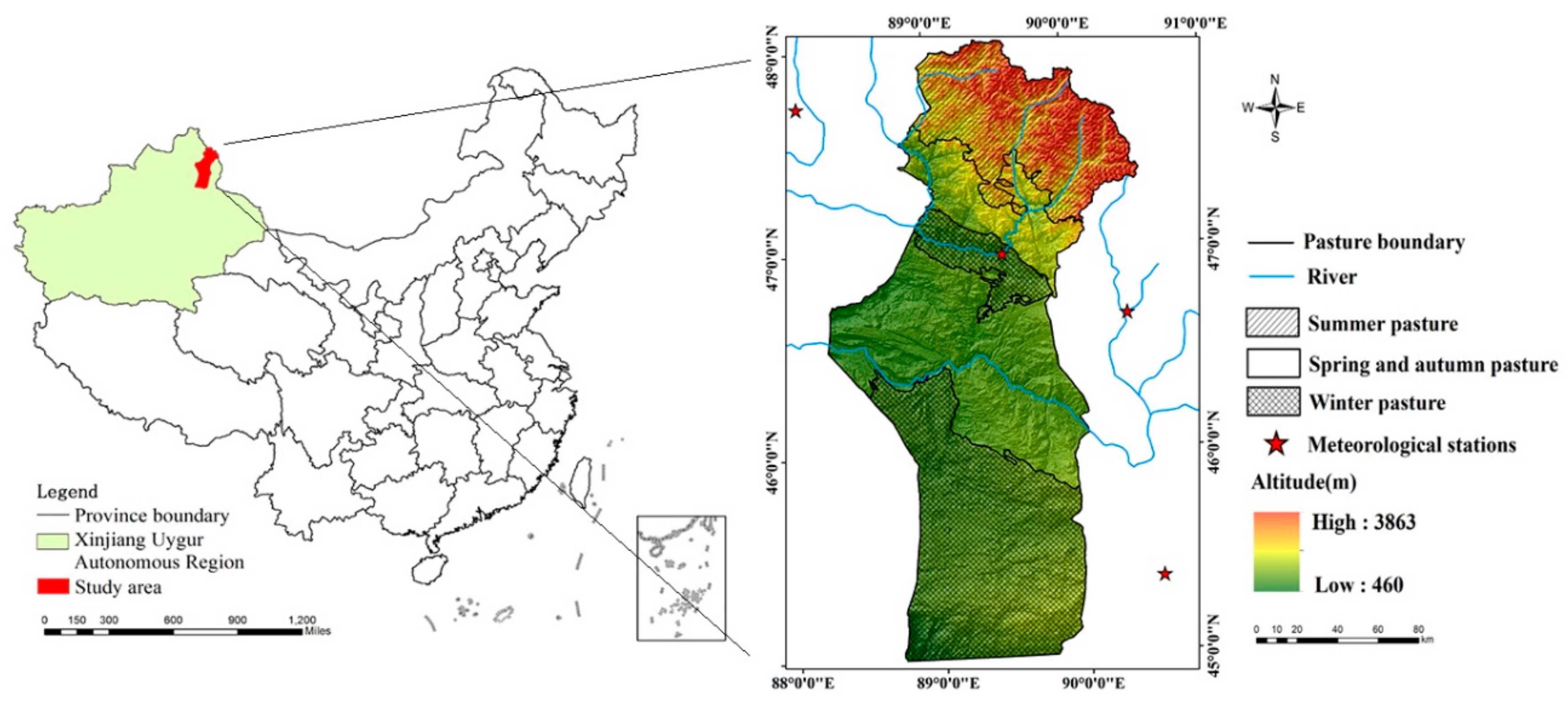
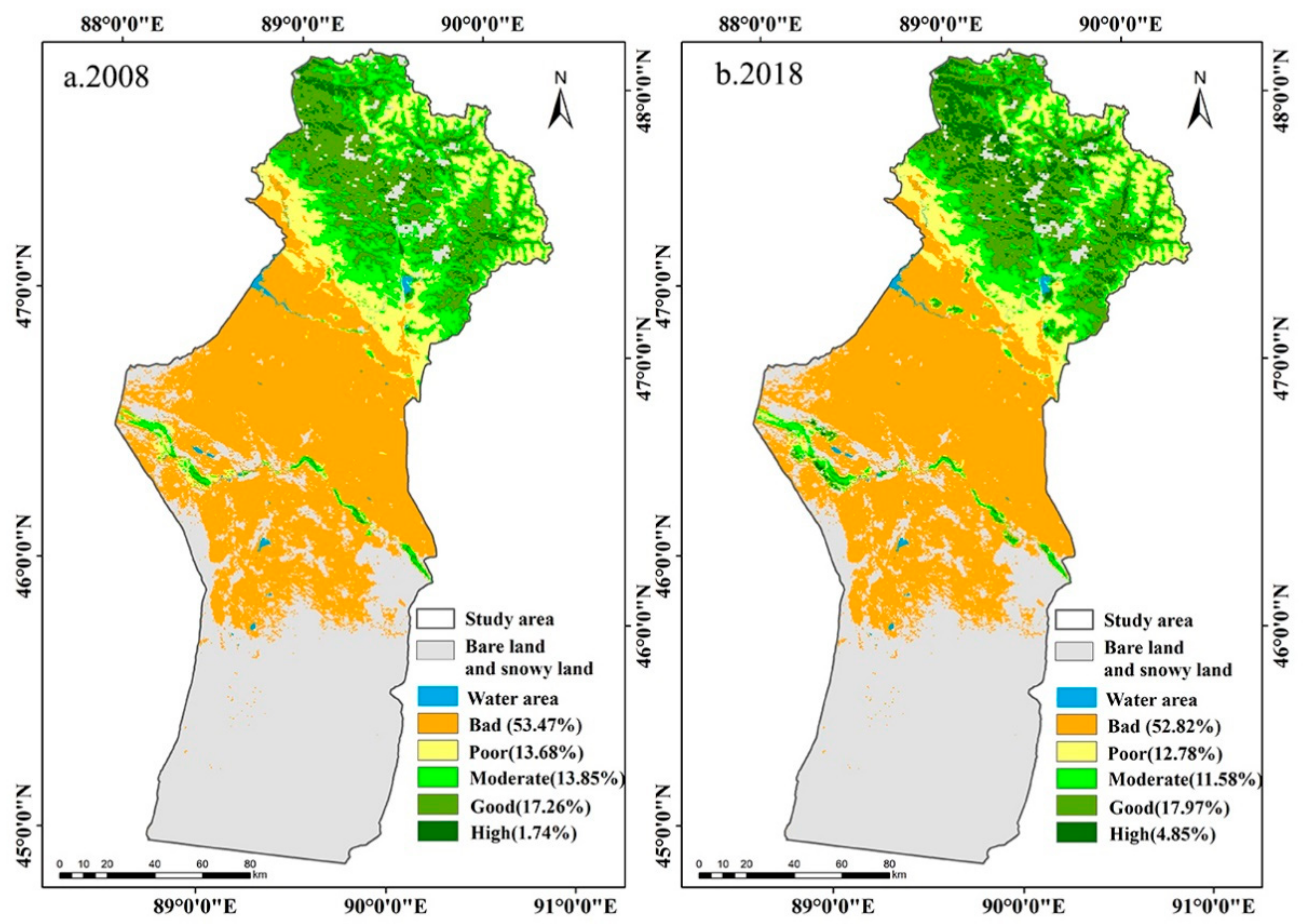
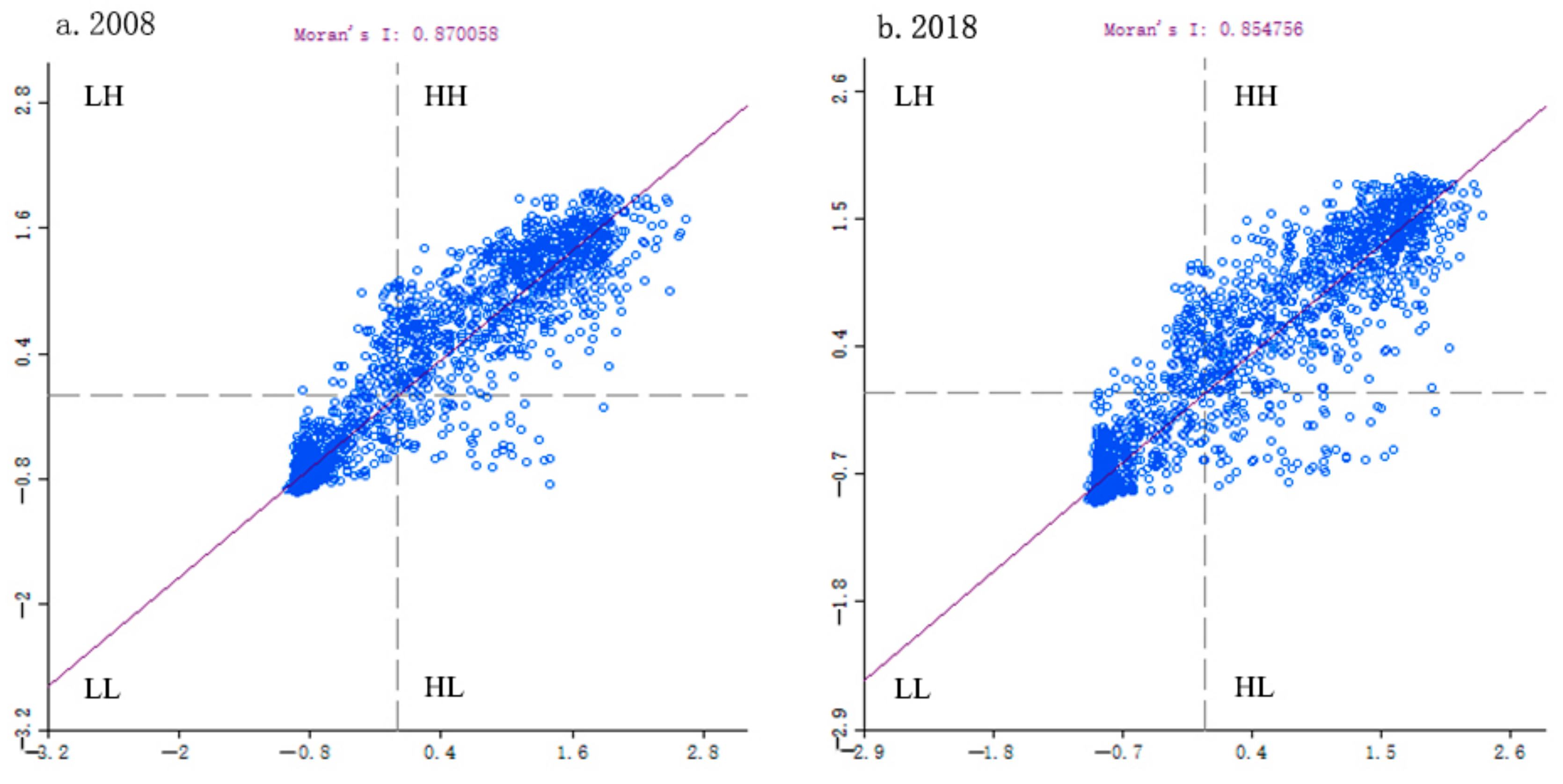
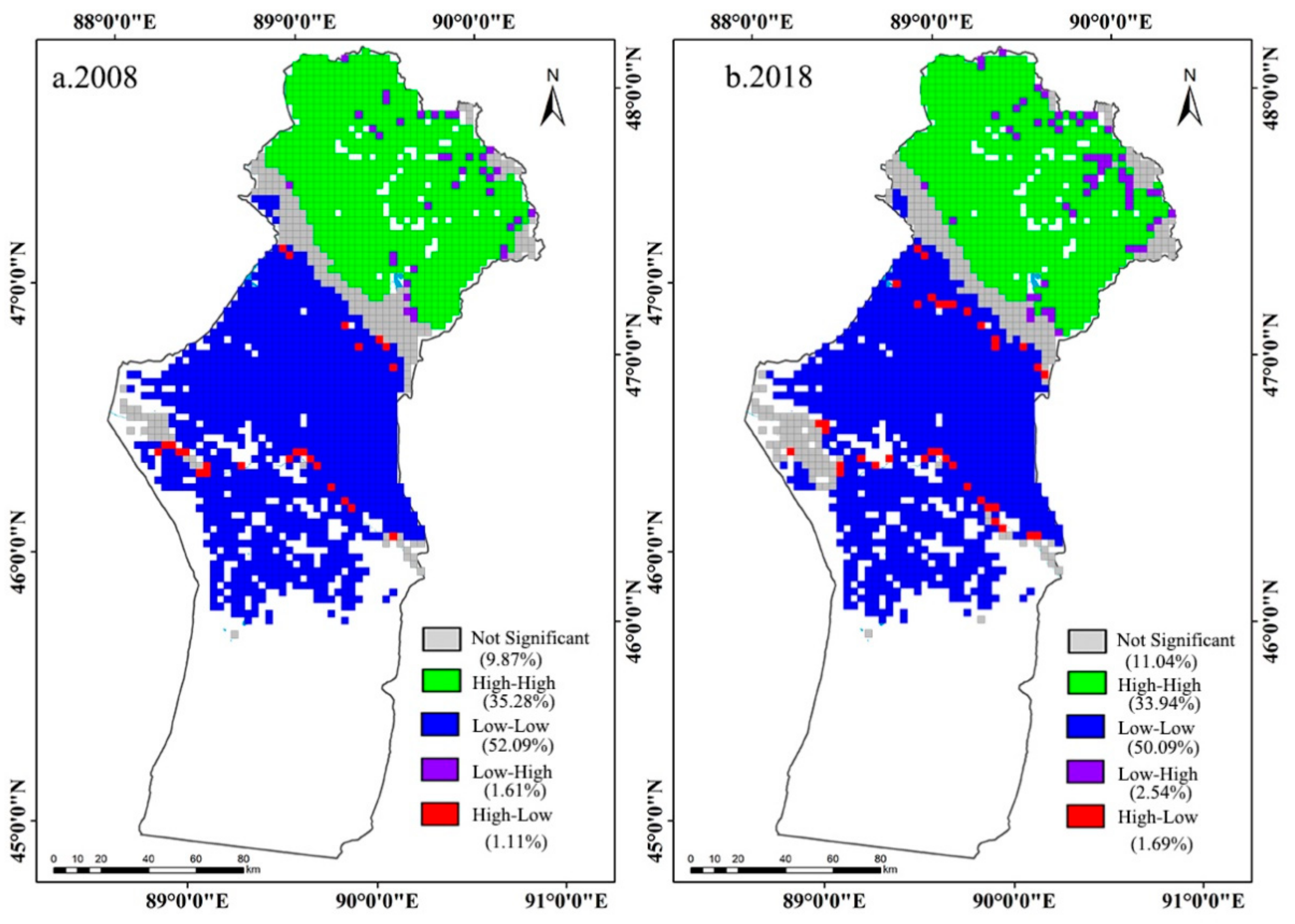
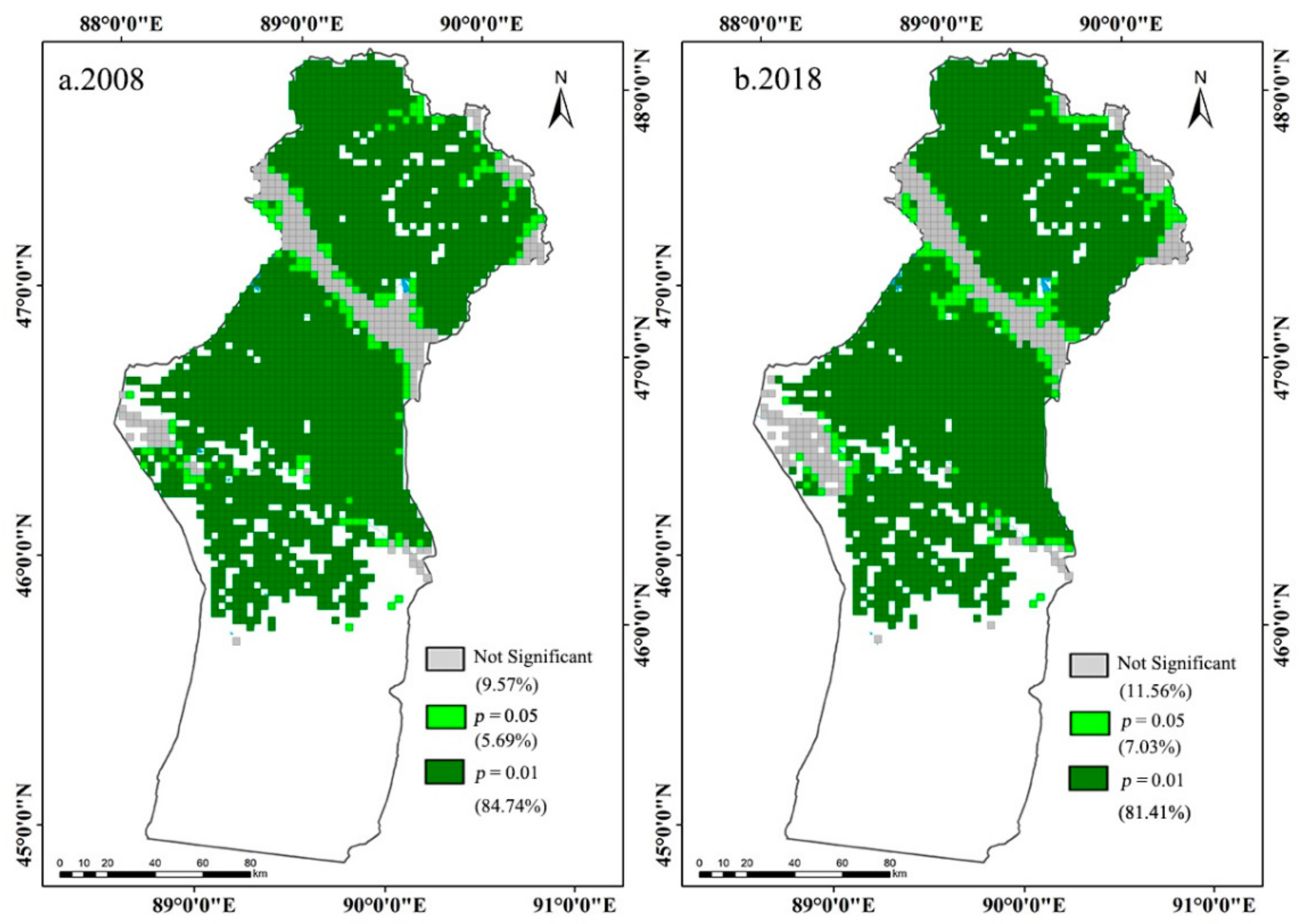


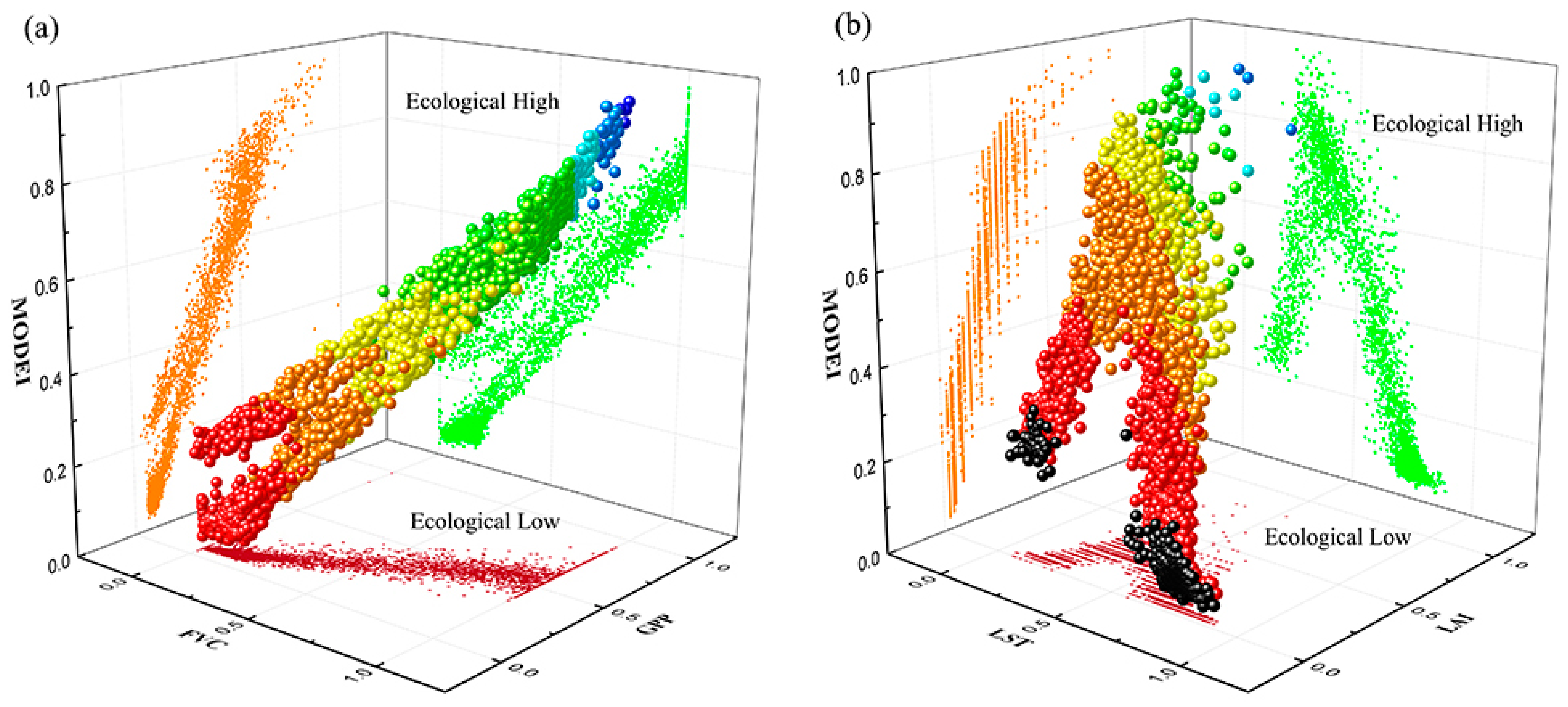


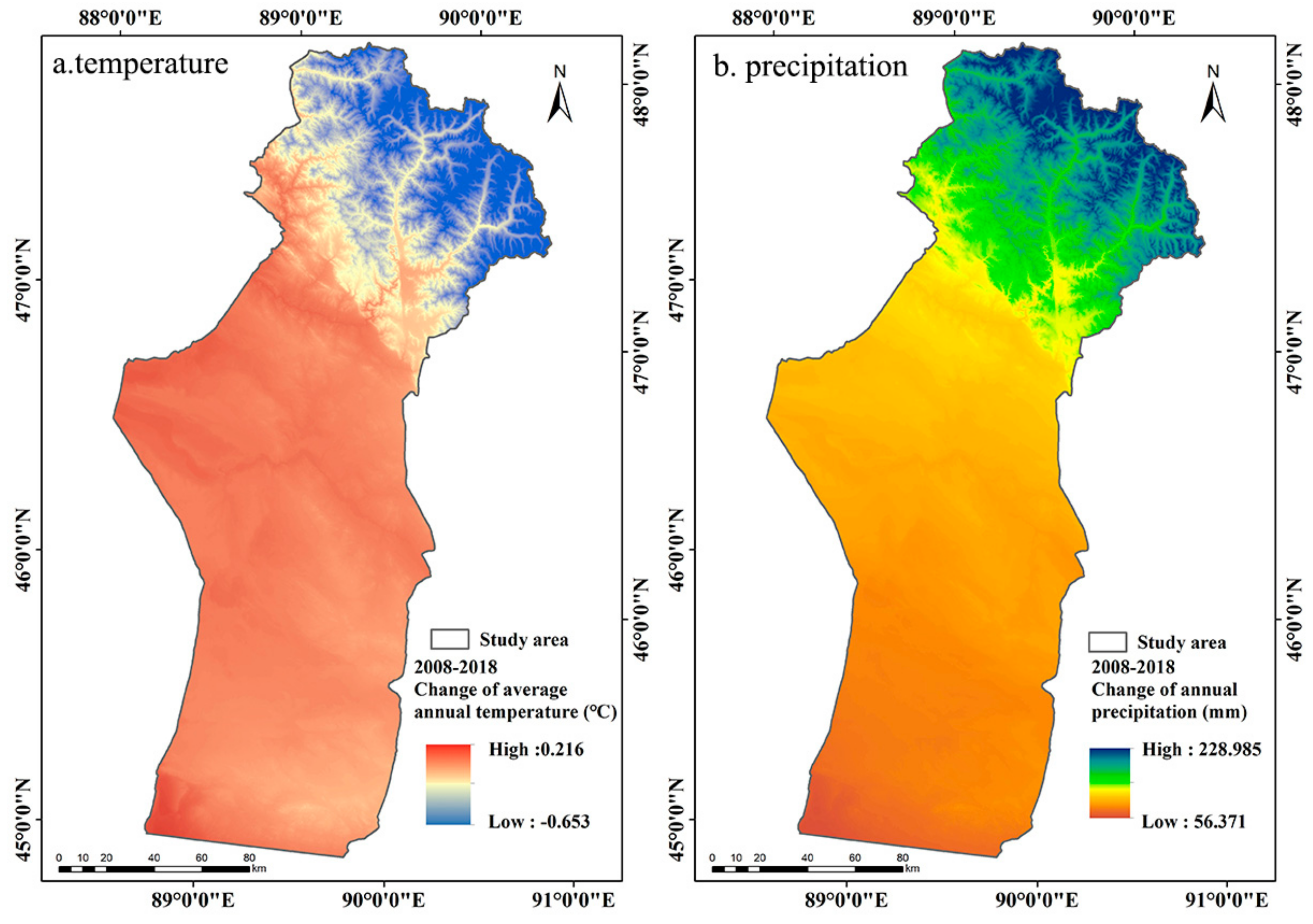

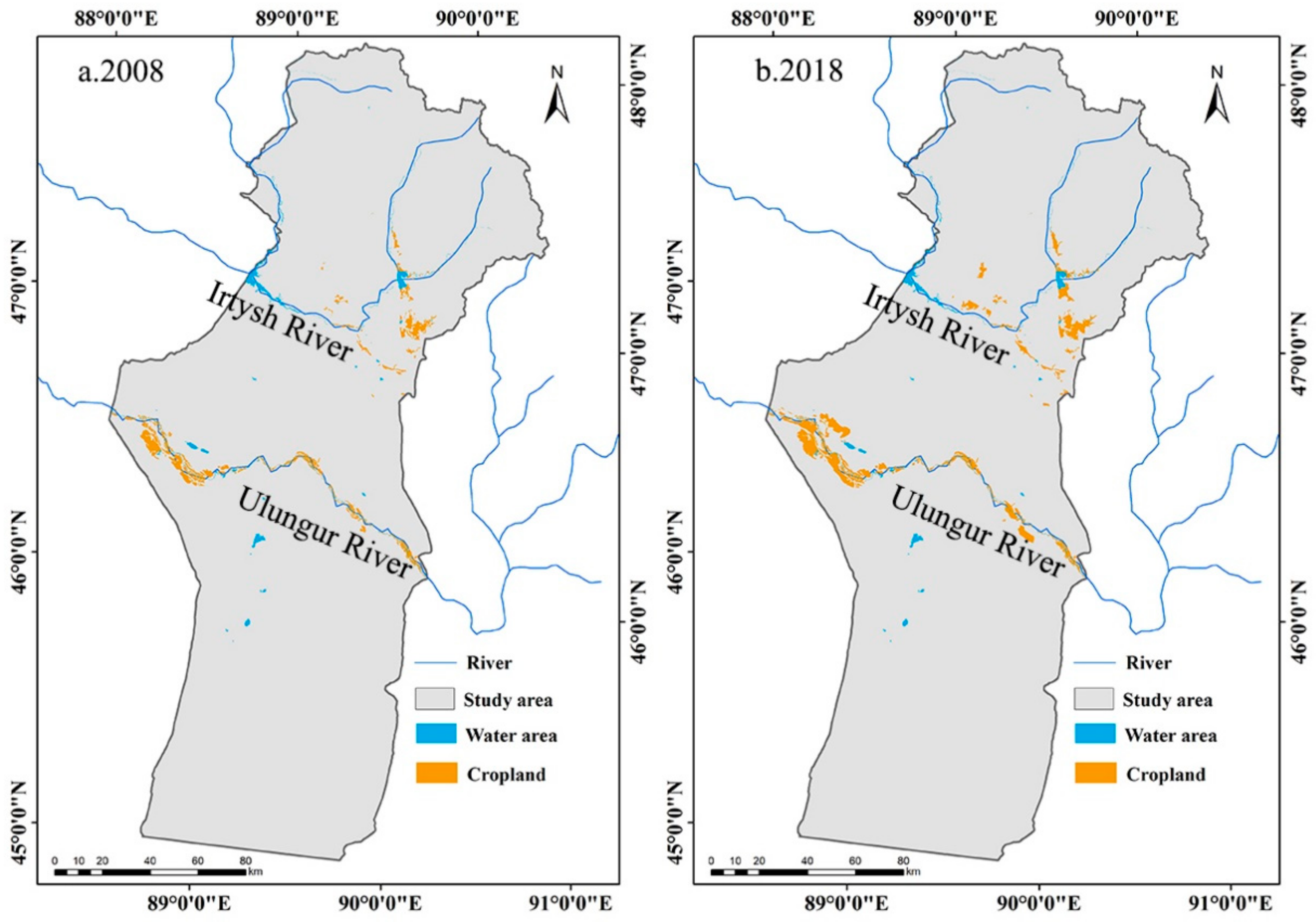
| Indicator | Product | Extracted Band | Temporal Resolution (d) | Spatial Resolution (m) |
|---|---|---|---|---|
| GPP | MOD17A2H | Gpp_500 m | 8 | 500 |
| FVC | MOD13A1 | 500m_16_days_NDVI | 16 | 500 |
| LAI | MOD15A2H | Lai_500 m | 8 | 500 |
| WET | MOD09A1 | sur_refl_b01 to 07 | 8 | 500 |
| LST | MOD11A2 | LST_Day_1 km | 8 | 1000 |
| Year | Indicators | PC1 | PC2 | PC3 | PC4 | PC5 |
|---|---|---|---|---|---|---|
| 2008 | FVC | 0.73481 | 0.34362 | 0.02455 | 0.57563 | −0.10015 |
| GPP | 0.43585 | 0.20132 | −0.03644 | −0.55731 | 0.67645 | |
| LAI | 0.27947 | 0.1872 | 0.07268 | −0.59759 | −0.72419 | |
| LST | −0.37923 | 0.74486 | 0.54284 | 0.02957 | 0.07628 | |
| WET | 0.21949 | −0.50153 | 0.83553 | −0.00846 | 0.04589 | |
| Eigenvalue | 0.04673 | 0.00551 | 0.00177 | 0.00048 | 0.00013 | |
| Percent eigenvalue | 85.5597 | 10.0876 | 3.2419 | 0.8798 | 0.231 | |
| 2018 | FVC | 0.75333 | 0.3866 | 0.09882 | −0.52096 | −0.04318 |
| GPP | 0.43101 | 0.15924 | −0.04565 | 0.68619 | 0.56208 | |
| LAI | 0.23866 | 0.10684 | 0.05217 | 0.50247 | −0.82245 | |
| LST | −0.38577 | 0.70148 | 0.59216 | 0.07011 | 0.05958 | |
| WET | 0.20235 | −0.56718 | 0.79673 | 0.01892 | 0.04714 | |
| Eigenvalue | 0.0543 | 0.00737 | 0.00115 | 0.0005 | 0.00016 | |
| Percent eigenvalue | 85.5477 | 11.606 | 1.8116 | 0.7863 | 0.2484 |
| Indicator | 2008 | 2018 | ||||||
|---|---|---|---|---|---|---|---|---|
| Minimum | Maximum | Mean | Standard Deviation | Minimum | Maximum | Mean | Standard Deviation | |
| GPP | 0 | 36.4 | 8.472 | 6.863 | 0 | 45.6 | 11.231 | 9.007 |
| FVC | 0 | 1 | 0.311 | 0.288 | 0 | 1 | 0.245 | 0.313 |
| LAI | 0 | 2.2 | 0.303 | 0.274 | 0 | 3.7 | 0.419 | 0.414 |
| WET | 0.005 | 0.582 | 0.231 | 0.081 | 0.006 | 0.68 | 0.255 | 0.093 |
| LST | 6.17 | 47.13 | 33.716 | 8.251 | 6.769 | 47.01 | 33.219 | 8.516 |
| MODEI | 0 | 1 | 0.292 | 0.254 | 0 | 1 | 0.303 | 0.278 |
| Level | 2008 | 2018 | ||
|---|---|---|---|---|
| Area (km2) | % | Area (km2) | % | |
| Bad (0–0.2) | 12906.14 | 53.47 | 12750.58 | 52.82 |
| Poor (0.2–0.4) | 3302.422 | 13.68 | 3084.042 | 12.78 |
| Moderate (0.4–0.6) | 3343.37 | 13.85 | 2795.152 | 11.58 |
| Good (0.6–0.8) | 4166.77 | 17.26 | 4338.041 | 17.97 |
| High (0.8–1.0) | 420.1287 | 1.74 | 1171.186 | 4.85 |
| Pasture Type | 2008 | 2018 | ||||
|---|---|---|---|---|---|---|
| Minimum | Maximum | Mean | Minimum | Maximum | Mean | |
| Spring and autumn pasture | 0.03 | 0.95 | 0.18 ± 0.17 | 0.01 | 0.96 | 0.19 ± 0.19 |
| Winter pasture | 0 | 0.76 | 0.09 ± 0.05 | 0 | 0.89 | 0.09 ± 0.08 |
| Summer pasture | 0.2 | 1 | 0.59 ± 0.16 | 0.19 | 1 | 0.62 ± 0.18 |
| Pasture Type | Change in p Values | Area (km2) | Percentage (%) | Total Percentage (%) | |
|---|---|---|---|---|---|
| Summer pasture | Decline | Significant decline | 17.72 | 0.07 | 5.41 |
| Decline | 1289.36 | 5.34 | |||
| Remain | Remain | 1548.52 | 6.42 | 6.42 | |
| Increase | Increase | 4587.03 | 19.01 | 19.01 | |
| Significant increase | -- | -- | |||
| Spring and autumn pasture | Decline | Significant decline | 41.69 | 0.17 | 17.5 |
| Decline | 4183.53 | 17.33 | |||
| Remain | Remain | 5884.9 | 24.38 | 24.38 | |
| Increase | Increase | 2476.77 | 10.26 | 10.57 | |
| Significant increase | 75.56 | 0.31 | |||
| Winter pasture | Decline | Significant decline | 23.62 | 0.1 | 5.41 |
| Decline | 1282.24 | 5.31 | |||
| Remain | Remain | 2355 | 9.76 | 9.76 | |
| Increase | Increase | 333.33 | 1.38 | 1.54 | |
| Significant increase | 38.73 | 0.16 | |||
| Whole region | Decline | Significant decline | 83.03 | 0.34 | 28.32 |
| Decline | 6755.13 | 27.98 | |||
| Remain | Remain | 9788.42 | 40.56 | 40.56 | |
| Increase | Increase | 7397.13 | 30.65 | 31.12 | |
| Significant increase | 114.29 | 0.47 | |||
Publisher’s Note: MDPI stays neutral with regard to jurisdictional claims in published maps and institutional affiliations. |
© 2021 by the authors. Licensee MDPI, Basel, Switzerland. This article is an open access article distributed under the terms and conditions of the Creative Commons Attribution (CC BY) license (https://creativecommons.org/licenses/by/4.0/).
Share and Cite
Bi, X.; Chang, B.; Hou, F.; Yang, Z.; Fu, Q.; Li, B. Assessment of Spatio-Temporal Variation and Driving Mechanism of Ecological Environment Quality in the Arid Regions of Central Asia, Xinjiang. Int. J. Environ. Res. Public Health 2021, 18, 7111. https://doi.org/10.3390/ijerph18137111
Bi X, Chang B, Hou F, Yang Z, Fu Q, Li B. Assessment of Spatio-Temporal Variation and Driving Mechanism of Ecological Environment Quality in the Arid Regions of Central Asia, Xinjiang. International Journal of Environmental Research and Public Health. 2021; 18(13):7111. https://doi.org/10.3390/ijerph18137111
Chicago/Turabian StyleBi, Xu, Bianrong Chang, Fen Hou, Zihan Yang, Qi Fu, and Bo Li. 2021. "Assessment of Spatio-Temporal Variation and Driving Mechanism of Ecological Environment Quality in the Arid Regions of Central Asia, Xinjiang" International Journal of Environmental Research and Public Health 18, no. 13: 7111. https://doi.org/10.3390/ijerph18137111
APA StyleBi, X., Chang, B., Hou, F., Yang, Z., Fu, Q., & Li, B. (2021). Assessment of Spatio-Temporal Variation and Driving Mechanism of Ecological Environment Quality in the Arid Regions of Central Asia, Xinjiang. International Journal of Environmental Research and Public Health, 18(13), 7111. https://doi.org/10.3390/ijerph18137111







